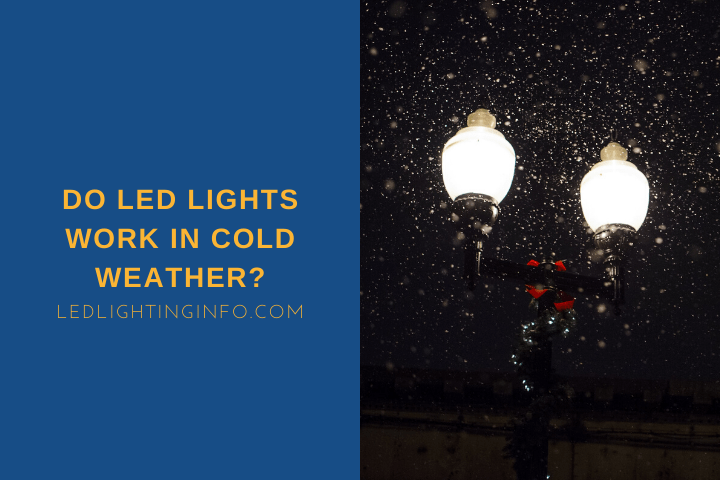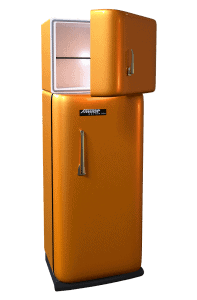If you live in a colder climate, you’re probably tired of unreliable outdoor lights that take a long time to warm up and switch on.
The last thing anyone wants during sub-zero weather is to be stuck inside a freezing cold garage or outhouse waiting for your lights to start working.
For anyone that has faced this problem in the past – it doesn’t have to be this way!
Unlike traditional methods of lighting, LEDs thrive in cold weather since they do not require heat to turn on. Instead, LEDs produce light using electricity, which makes them the preferred solution for cold, outdoor environments.
This durability means that LED lights are more energy-efficient and safer for the environment than traditional alternatives, which is excellent for those of us who are conscious of our environmental footprint.
Whether you’re curious about how LED bulbs work or you’re considering switching your outdoor lights, this blog post is for you.
In this article I will be covering:
- Why LEDs work so well in cold weather
- Reasons why LED bulbs might flicker in cold weather
- Why you should choose LED bulbs over CFLs
- The operating temperature of LED lights
- Whether LED bulbs are suitable for freezers
Carry on reading to find out more…
LED Lights and Cold Temperature
According to the Lighting Research Centre, cold weather enhances the performance of LED bulbs. In fact, they argue that “the cooler the environment; the higher an LED’s output will be.”
But why is this?
LEDs are semiconductors, which means their materials are neither insulators or conductors. Electricity causes free electrons in a negatively charged component to pass over to holes in a positively charged component. As this happens, light is emitted.
The heat harms this process and causes mutations in the bulb’s behavior. At high temperatures, the forward voltage and lumen output of an LED bulb is decreased, which reduces the bulbs’ lifespan.
This means that thermal management of LEDs is essential.
Nowadays, most LED bulbs have heat sinks. Heat sinks absorb excess heat from the diode and create a path to disperse it to an outside source.
Well-designed heat sinks can lower the internal junction temperature of a bulb by 10 – 30°C (50 – 86°F).
During cold weather, there is no need for heat sinks as the external temperature keeps diodes cool and working optimally. As long as outdoor LED light fittings are protected from water, cold temperatures will actually prolong the life of an LED.
Will LED Lights Flicker in Cold Weather?
As I’ve already mentioned, the performance of LEDs is not affected by cold weather. If you’ve decided to install LED lights outside your home or property, you should have no reason to worry about flickering during the colder months.
However, I understand that sometimes impossible things can happen. If you’ve noticed that your LED lights are flickering when the temperature drops, this is probably because part of the bulbs’ internal components has frozen.
This is common in cheaper components, as temperature-resistant materials can be expensive. Manufacturers of cheaper LEDs tend to cut costs by using substitutes that are not weather-resistant.
My advice is to invest more money in high quality LED lights that are made from good materials.
These lights are guaranteed to remain bright and stable during cold winter months. This is why LEDs make great flood lights, street lights, and decorative lights in cold climates.
Is it Safe to Use CFL Bulbs in Cold?
If you’re looking for lights to use in cold climates, LEDs are one option. But what about CFLs? CFLs (Compact Fluorescent Lights) may seem like a favorable option due to their long lifespan and cost-efficiency. But, unfortunately, CFLs do not perform well in cold weather.
In CFLs, electricity flows from a positive electrode, through a tube containing argon gas and mercury vapor, to a negative electrode. When the electrons come into contact with the mercury atoms, they begin to produce ultraviolet (UV) rays, which are invisible to the human eye.
These UV rays then hit a fluorescent coating on the interior of the tube that converts them to visible light.
For this process to begin, most CFLs require an external temperature between -10°C and 60°C (14°F and 140°F). This means that CFL lights will simply not turn on when exposed to climates lower than -10°C (14°F), which is an obvious downfall.
CFLs can also be hazardous if they heat up and cool down too quickly, as this puts excess pressure on the glass bulb and may cause it to shatter.
This is dangerous due to the mercury vapor inside the bulb, which requires careful disposal.
Although this is a rare occurrence, it’s clear that CFLs are neither a safe or reliable option for outdoor lighting in cold environments
What is the LED Operating Temperature Range?
The exact operating temperature of an LED varies from bulb to bulb. However, as a general rule of thumb, most LED lights will work between -30°C and 60°C (-22°F and 140°F).
This means that LEDs are suitable for a wide range of applications, as they can easily survive hot and cold climates.
Moreover, it’s widely accepted that the optimal temperature for an LED bulb is 25°C (77°F). Typically, this is the temperature used to calculate a bulb’s L70 lifespan.
So light with an L70 of 50,000 will last 50,000 hours at 25°C (77°F) before it needs replacing.
It’s worth noting that there is a difference between the junction temperature of a bulb and the ambient temperature.
Junction temperature refers to the bulb’s internal elements. Ambient temperature, whereas, refers to the temperature of the external environment.
Even with heat sinks, the junction temperature of a bulb is usually much hotter than the ambient temperature. So while the ambient temperature may be an average 13°C (55°F), the junction temperature could be 33°C (91°F).
Research by the Lighting Research Centre found that 25°C is the optimal temperature for the junction of an LED bulb, rather than the optimal ambient temperature.
This shows that whilst LED lights will work in both hot and cold climates, if the junction temperature surpasses 25°C, light output will be reduced.
Will LED Bulb Work in Freezer?
The short answer: Yes.
LEDs love being cold, which makes them perfect for use in fridge freezers. In fact, most modern fridge freezers on the market now use LED lights. There are two main benefits to this.
Firstly, LEDs produce minuscule amounts of heat. With non-LED lights, if you leave your freezer door open for a long time, the light will start to heat up.
Your freezer then has to work hard to cool the freezer back down. With LED lights, this is not an issue. Essentially, by using non-LED lights, you’re creating more work for your freezer.
Secondly, and following on from the last point, fridge freezers with LED lights are therefore cheaper to run. MiracleLED claims that replacing 40 – 60W bulbs with their 3W LED alternative can save up $55 per year, as it costs just $0.36 per year to operate.
Final Words
As you can see, the case for using LED bulbs in cold environments is strong.
Due to the lack of heat required, LED lights are a safe and durable solution that you should be considering for your home and property, whether in your fridge, freezer or your garage!
But remember, before you purchase an LED light, always check its specific operating temperature, as this varies from bulb to bulb.
- Do you have LED lights outside your home during cold weather?
- If not, what kind of lights are you currently using? Would you ever consider changing?
Let me know in the comments down below!
Looking for an LED bulb but not sure what type you need?
Check out my free bulb picker and select the right bulb within few clicks.




Comments are closed.